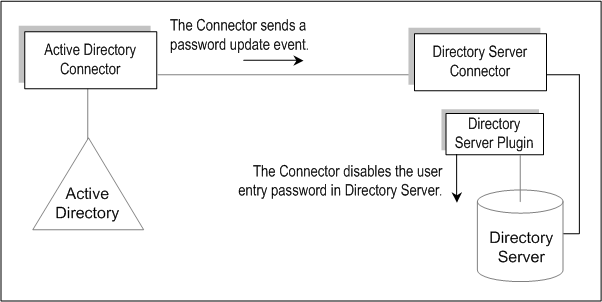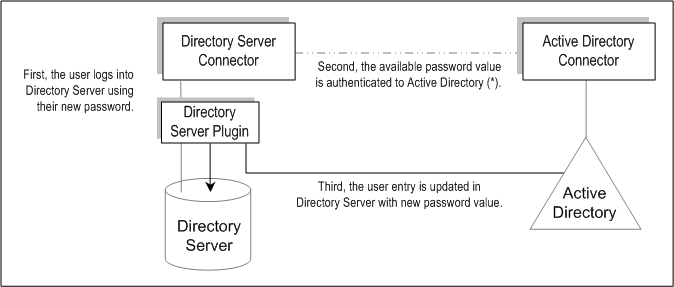Using On-Demand Password Synchronization to Obtain Clear-Text Passwords
While Active Directory supports the same password filter as Windows NT, you must install the password filter DLL on every domain controller instead of just the Primary Domain Controller (PDC). Because this can be a significant installation burden, Identity Synchronization for Windows uses a different approach, called on-demand password synchronization, to synchronize password changes from Active Directory to Directory Server.
On-demand password synchronization provides a method to obtain new password values on Directory Server when the user tries to log-in after their password changes on Windows 2000.
On-demand password synchronization also allows you to synchronize passwords on Active Directory without the need of a password filter DLL.
 The on-demand password synchronization process occurs as follows:
The on-demand password synchronization process occurs as follows:
-
User presses Ctrl-Alt-Del on a Windows workstation and changes his or her password. New passwords are stored in Active Directory.
-
The Active Directory Connector polls the system at scheduled intervals.
When the Connector detects the password change (based on changes made to the USNchanged (Update Sequence Number) and PwdLastSet attributes), the Connector publishes a message on Message Queue about the password change. The message is transferred on an SSL-encrypted channel.
Figure 3–7 On-Demand Password Synchronization-Part 1

-
The Directory Server Connector receives the password change message from Message Queue (over SSL).
-
The Directory Server Connector sets the user entry’s dspswvalidate attribute to true which invalidates the old password and alerts the Directory Server Plug-in of the password change.
-
When the user tries logging on, using an LDAP application (such as Portal Server) to authenticate against the Directory Server, the Sun Java System Directory Server Plug-in detects that the password value in the Directory Server entry is invalid.
-
The Directory Server Plug-in searches for the corresponding user in Active Directory. When the Plug-in finds the user, the Plug-in tries to bind to Active Directory using the password provided when the user tried logging into Directory Server.
Note –On-demand password synchronization requires the application to use simple authentication against the Directory Server instead of using a more-complex authentication mechanism, such as SASL Digest-MD5.
-
If the bind against Active Directory succeeds, then the user provided his or her new Active Directory password and the Directory Server Plug-in set the password and removed the invalid password flag from the user entry on Directory Server.
Figure 3–8 On-Demand Password Synchronization-Part II

Note –If the user authentication fails, the user entry password remains in Directory Server and the passwords on Directory Server and Active Directory will be out-of-sync until the user logs in with a valid password (one that authenticates to Active Directory).
- © 2010, Oracle Corporation and/or its affiliates
